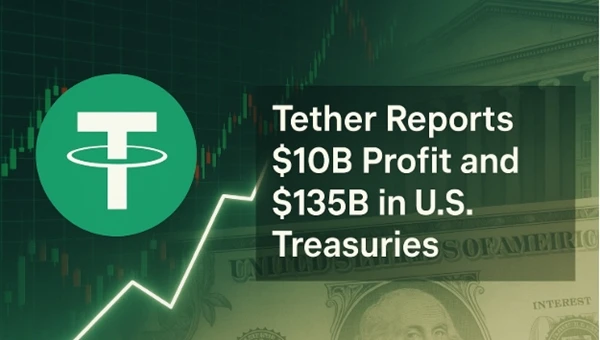

Tether: Q3 Results
According to the attestation linked to its Q3 2025 results, Tether issued more than US$17 billion of new USDT tokens in the third quarter alone, raising its total circulating supply to roughly US$174 billion to US$183 billion.
- Its reserves now exceed US$181 billion, with liabilities at about US$174.4 billion, leaving a surplus buffer of about US$6.8 billion.
- The company also holds gold and bitcoin allocations valued at US$12.9 billion and US$9.9 billion, respectively, representing roughly 13 % of its total reserve mix.

What do the Treasury Holdings Mean?
Holding US$135 billion in U.S. government debt situates the company among the top 20 global holders of such debt, an unusual status for a private firm. By comparison, many sovereign wealth funds and countries hold smaller portfolios. This level of exposure highlights how Tether’s reserve strategy relies heavily on highly liquid, government-backed instruments while maintaining its stable-coin peg and liquidity demands.
Stablecoins like USDT are designed to mirror fiat currencies while offering digital-asset flexibility. The scale of Tether’s holdings in Treasuries shows how the stable-coin issuer has become a major player in the capital markets traditionally dominated by banks and sovereign institutions.
Its strategy contrasts with many newer issuers that rely heavily on short-dated commercial papers or less-liquid assets. In this sense, Tether’s model reflects a convergence of crypto infrastructure and institutional asset-management practices.
With size comes scrutiny. Tether’s massive Treasury position exposes it to interest-rate, liquidity, and counterparty risks. Although the firm maintains a surplus buffer and the backing of its tokens appears intact in the attestation, observers caution that stable-coin issuers operate in an evolving regulatory environment.
For instance, the distinction between attestations and full audits remains a topic of debate among financial regulators and market participants. Moreover, Tether’s user base reportedly exceeds 500 million globally, which amplifies the systemic implications of any disruption in its operations.
Comparisons Within the Crypto-Asset Sector
Tether’s scale in both profitability and reserve strength sets it apart in the stablecoin market. Rival issuers like Circle’s USDC, despite maintaining a strong reputation for transparency, reported approximately $28 billion in circulation as of late 2025, less than a fifth of USDT’s supply.
Meanwhile, Circle’s attested reserves from the same period included roughly $22 billion in U.S. Treasuries, compared to Tether’s $135 billion.
Even Binance’s BUSD, once a top-three stablecoin, saw shrinking reserves and circulation after regulatory setbacks in 2023, eventually leading to a full phase-out.
Smaller algorithmic or overcollateralized stablecoins, such as MakerDAO’s DAI or Liquity’s LUSD, operate with decentralized models but lack the institutional-grade liquidity and vast Treasury exposure seen with Tether.
This disparity in reserve composition and market presence gives Tether a structural advantage, especially during market disruptions, where treasury-backed stability and liquidity are critical.
Implications for Markets and Investors
Tether’s results carry multiple implications.
- First, they suggest that the stable-coin layer is becoming deeply intertwined with mainstream finance rather than remaining a niche crypto play.
- Second, the sheer size of Tether’s Treasury footprint means that changes in its strategy could ripple into broader debt markets.
- Third, for institutional investors and regulators, this signals that digital-asset firms are not only trading platforms or token issuers, but are significant asset managers in their own right.
What to watch going forward?
Looking ahead, key questions include:
- Will Tether’s issuance growth continue at the same pace, and what will the corresponding reserve strategy look like?
- Will regulatory authorities require greater transparency or limit the scale of such firms’ Treasury holdings?
- How will the firm balance yield-seeking, liquidity, and regulatory demands in an environment of rising rates and potential macro shocks?
He has worked with several companies in the past including Economy Watch, and Milkroad. Finds writing for BitEdge highly satisfying as he gets an opportunity to share his knowledge with a broad community of gamblers.
Nationality
Kenyan
Lives In
Cape Town
University
Kenyatta University and USIU
Degree
Economics, Finance and Journalism


Facts Checked by Vlad Hategan

 Fact checked by
Fact checked by 
 eabungana@gmail.com
eabungana@gmail.com 